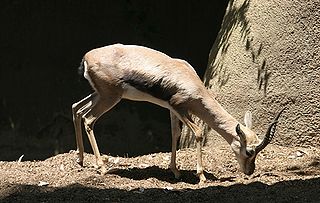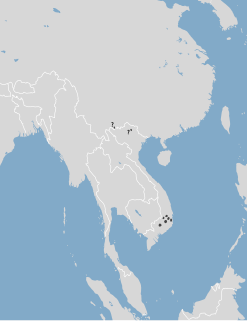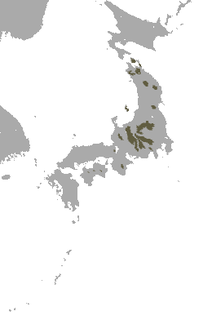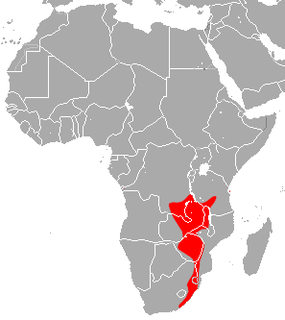
The International Union for Conservation of Nature (IUCN) Red List of Threatened Species, founded in 1964, is the world's most comprehensive inventory of the global conservation status of biological species. It uses a set of precise criteria to evaluate the extinction risk of thousands of species and subspecies. These criteria are relevant to all species and all regions of the world. With its strong scientific base, the IUCN Red List is recognized as the most authoritative guide to the status of biological diversity. A series of Regional Red Lists are produced by countries or organizations, which assess the risk of extinction to species within a political management unit.

Speke's gazelle is the smallest of the gazelle species. It is confined to the Horn of Africa, where it inhabits stony brush, grass steppes, and semi deserts. This species has been sometimes regarded as a subspecies of the Dorcas gazelle, though this is now widely disregarded. Severe habitat fragmentation means it is now impossible to assess the natural migratory or nomadic patterns of G. spekei. Its numbers are under threat, and despite an increase in population, the IUCN in 2007 announced its status had changed from vulnerable to endangered. A captive population is maintained, and the wild population exists in the lower tens of thousands. As of 2008, this gazelle is classified as endangered under the IUCN Red List.

The conservation status of a group of organisms indicates whether the group still exists and how likely the group is to become extinct in the near future. Many factors are taken into account when assessing conservation status: not simply the number of individuals remaining, but the overall increase or decrease in the population over time, breeding success rates, and known threats. Various systems of conservation status exist and are in use at international, multi-country, national and local levels as well as for consumer use.
The blackfin cisco was a North American salmonid fish in the freshwater whitefish sub-family Coregoninae. This silvery, deep-bodied fish with black fins, large eyes, a blunt snout and a terminal mouth, was one of the largest forms of ciscoes. The blackfin cisco used to inhabit the Great Lakes of North America until recently, but has been reported to have gone extinct. The blackfin cisco is a member of the C. artedi complex, whose taxonomy has not yet been resolved, and it may not represent a valid species.

The São Tomé shrew is a white-toothed shrew about 3.0 in (7.6 cm) long found only on São Tomé Island, São Tomé and Príncipe. It is listed as a critically endangered species due to habitat loss and a restricted range. It was discovered in 1886. The population continues to decrease, making these animals rare. It is found only on São Tomé Island, a small island that is actually a shield volcano that rises out of the Atlantic Ocean.

A least-concern species is a species that has been categorized by the International Union for Conservation of Nature (IUCN) as evaluated as not being a focus of species conservation because the specific species is still plentiful in the wild. They do not qualify as threatened, near threatened, or conservation dependent.

A near-threatened species is a species which has been categorized as "Near Threatened" (NT) by the International Union for Conservation of Nature as that may be vulnerable to endangerment in the near future, but it does not currently qualify for the threatened status.

A species that is extinct in the wild (EW) is one that has been categorized by the International Union for Conservation of Nature as known only by living members kept in captivity or as a naturalized population outside its historic range due to massive habitat loss.

The black spine-neck swamp turtle, also commonly known as the spiny-neck turtle or Spix's sideneck turtle, is a species of turtle in the family Chelidae. The species is endemic to South America, specially in the Southern Cone region.

The Himalayan mole or short-tailed mole is a species of mammal in the family Talpidae.

The small-toothed mole is a species of mammal in the family Talpidae. It is found in Di Linh, in southern Vietnam, and Rakho near the border of Vietnam and China, and in southern Yunnan, China, near the Vietnamese border. It is likely that it has a broader distribution, especially in places between the currently known locations.

The Shinto shrew is a species of shrew of the genus Sorex that lives only on the islands of Japan. It is a mole-like mammal with a pointed snout, very small ears, and a relatively long tail. Like most shrews, it is tiny, has poor eyesight, and a very good sense of hearing and smell which it uses to locate its prey, mainly insects.

Swinny's horseshoe bat is a species of bat in the family Rhinolophidae. In English, R. swinnyi is commonly referred to as Swinny's horseshoe bat. In Afrikaans, it is commonly referred to as Swinny se saalneusvlermuis. This species belongs to the African clade. R. swinnyi was discovered by an African collector H. H. Swinny. They have been recorded in Angola, Republic of the Congo, Mozambique, South Africa, Tanzania, Zambia, Zimbabwe, and Malawi.
Macroperipatus insularis is a species of velvet worm in the Peripatidae family. It may be found in Jamaica, Hispaniola, or Haiti. The species is listed as Endangered on the IUCN Red List.
Ceuthonectes is a genus of copepods in the family Canthocamptidae. It includes the Slovenian endemic species C. rouchi, which is listed as a vulnerable species on the IUCN Red List. Ceuthonectes contains the following species:
Proasellus is a genus of isopod crustaceans in the family Asellidae. Two of its species, P. parvulus and P. slovenicus, are Slovenian endemics which are listed as vulnerable species on the IUCN Red List.

The Christmas Island shrew, also known as the Christmas Island musk-shrew is an extremely rare or possibly extinct shrew from Christmas Island. It was variously placed as subspecies of the Asian gray shrew or the Southeast Asian shrew, but morphological differences and the large distance between the species indicate that it is an entirely distinct species.

Endangered species as classified by the International Union for Conservation of Nature (IUCN), are species which have been categorized as very likely to become extinct in the near future. On the IUCN Red List, endangered is the second most severe conservation status for wild populations in the IUCN's schema after Critically endangered (CR). In 2012, the IUCN Red List featured 3,079 animal and 2,655 plant species as endangered (EN) worldwide. The figures for 1998 were 1,102 and 1,197 respectively.











